Sound has always been one of the biggest stumbling blocks for HD-DSLRs for me. Documentary filming is one of my biggest passions and until now I have always had to try and cope with dual system sound or a mic like the Rode Video Mic plugged into the mic input of the camera and left on auto.
XLR adaptors for cameras are nothing new. Beachtek and other companies have been doing them for donkey’s years. But the HD-DSLRs that I use. The Canon 7D, 1DmkiV and 7D have big problems with sound. The input being a puny 3.5mm jack is of course fixed by these XLR adaptors but that is only part of the issue. The main problems are auto gain control, otherwise known as AGC. The lack of a headphone jack (!), no onscreen meters. It just plain sucks!!
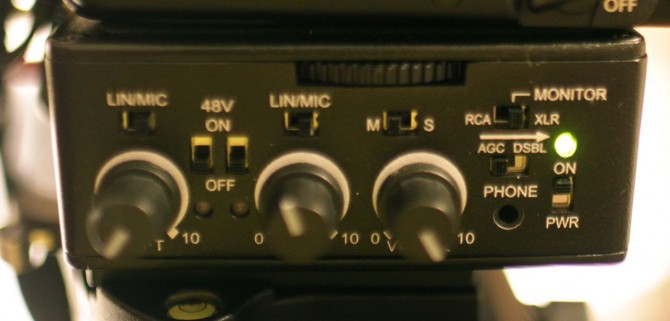
Now the previous Beachtek adaptor that I played with really wasn’t good enough for me. It’s passive so had no amplification making using certain microphones a real no-no. The AGC of the camera would try and bump up the levels if the signal was too low causing nasty hiss all over the sound. Also the HD-DSLRs with their current firmware have no audio meters. The SLR has no proper meters on it. But it does have lights that flicker green for good levels and red for bad. Not exactly ideal but better than nothing. The new 5Da does have proper meters but is’s passive device.
I have just received a pre-production DXA-SLR XLR adaptors from Beachtek. I have been bugging them for ages to try and review one of their units and finally have got one! The SLR is an active adaptor and has pre-amps in it making it usable for just about all mics out there. It also has +48v phantom power so can power your mics that need it. There are also gain switches underneath the unit. There is a +15db switch for either of the two channels.
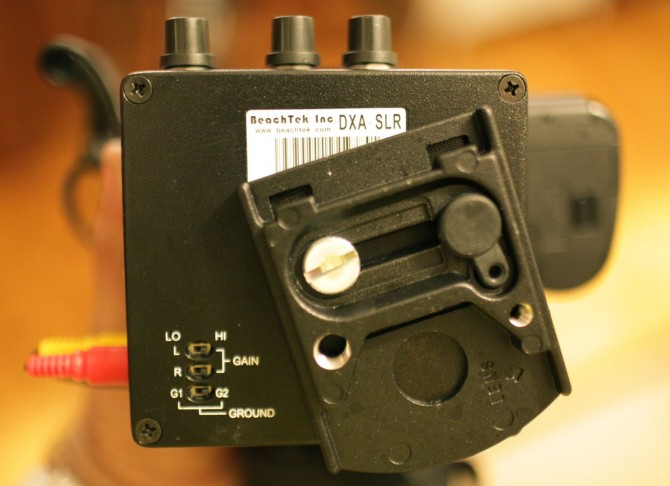
Other plusses. It’s smaller and more sturdy. Made of die cast aluminium. The old one also covered the battery compartment. A right pain. This one doesn’t!
A very key and incredibly neat feature is the ability to “disable” auto gain control on the camera. It does this in a very clever way. This is from the manual…”This switch is a means to disable the wild swings of the Auto Gain Control in the camera. It activates an inaudible tone of 20 kHz to the left channel (when set to STEREO operation) that prevents the Auto Gain Control from increasing the gain to its maximum level. This reduces the hiss that normally occurs when the camera is recording audio during quiet moments. This inaudible tone is recorded by the camera but can be easily filtered out if necessary.”…and you know what…it actually bloody works…remarkably well!! This is a big deal, until we get official firmware that disables this that bloody AGC for us, this feature it a bit of major step forward for HD-DSLR sound, not quite a game changer but damn close! Of course magic lantern firmware does this too, but this is much simpler and easier and just a flick of a switch. Although magic lantern offers way more additional features than this.
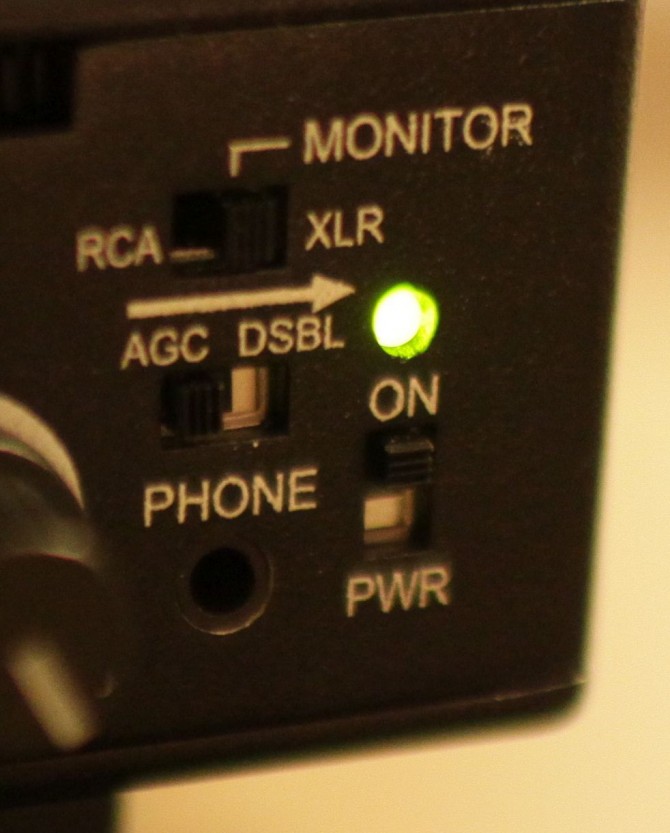
Another very neat feature (if you aren’t using magic lantern as that disables the AV port and turns it into a headphone only output without disabling the LCD screen) is the phono jack inputs which when plugged into the AV jack of the camera let you hear, through the Beachtek box, the sound that has been recorded in camera. This was previously not possible. Of course the LCD screen will turn off when you play back sound with the AV lead plugged in and the only way you will see a see a picture is if you have a composite monitor plugged into the video signal. But it’s GREAT to finally be able to play back sound recorded in camera and check how it sounds. Before this I had to use the awful crappy in built speaker of the camera or offload the clip to the computer. Again, not ideal. Be great if we just had a headphone jack, but a nice feature that Beachtek have added. This is unique to the SLR adaptor.
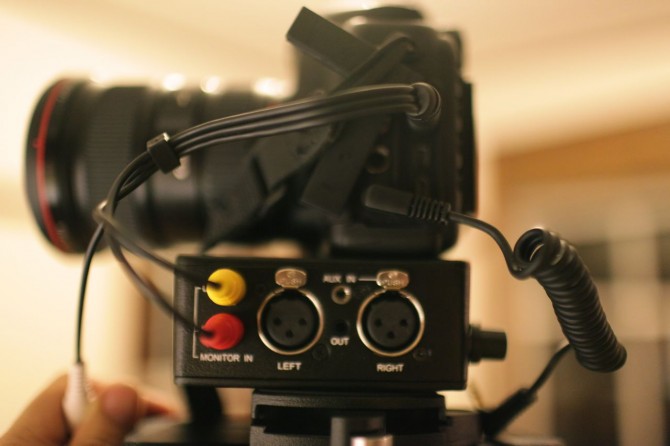
I have used the Juiced Link XLR adaptor too, this does have pre-amps and gives you very nice sound, but is lacking a few important connections for me, although their new DN101 accessory fixes most of issues by giving it headphone jack, meters and an AGC disable trick too I hope to use this one too soon, it’s sitting in London waiting for me!!… this new Beachtek adaptor has set the new bar for XLR adaptors and means the next time I shoot a doc with my 5D I am going to probably record in camera sound for the very first time. This is a quite a big deal!
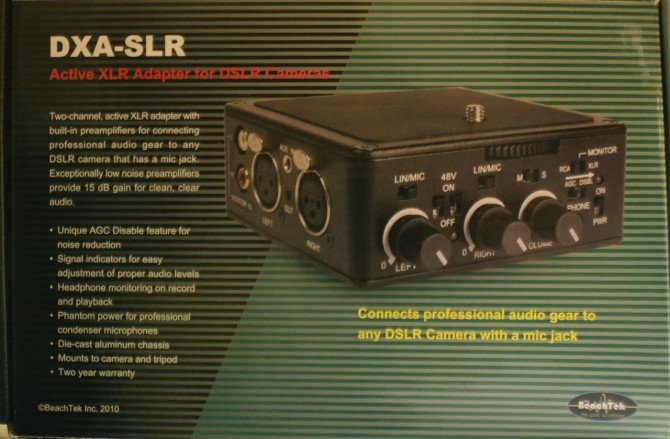
I am going to use this with my incredibly cool new microphone. The Holophone Portamic 5.1 pro. That captures Pro logic II sound straight into the Beachtek box!! when played back through an amp with Pro Logic II decoding you should get great sound. Also you can take the 6 channels of sounds embedded in the stereo and decode them with a piece of software called Surcode for Pro Logic II.
Of course REALLY good sound is key and this won’t be as good quality as recording sound on say a Zoom H4N which can record at a much higher bit rate and sound a lot better…but when operating one man band I feel we finally have a really usable option now. This is great news for a lot of people.
One thing I would love to see on this is proper audio meters like the new DXA-5DA has…but all the other new features make up for it…just. But please Beachtek stick some proper meters on this!
I understand this won’t be available until around the end of March. But make sure you get in early to get one. Beachtek sold out of the DXA-5D adaptor pretty fast!!

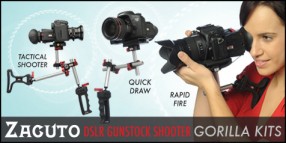
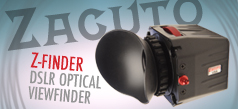


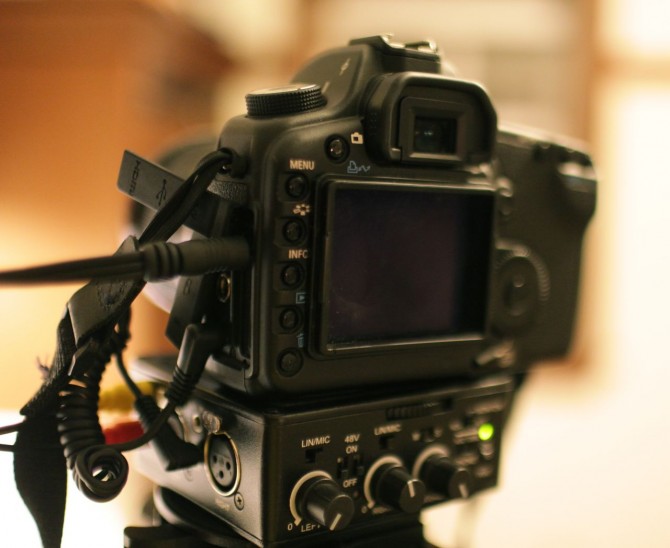
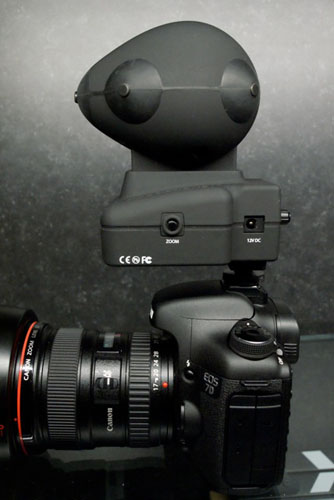
86 comments
wait, Zoom has a Z4N out now? when did this happen :/
sorry Dan, typo…
phew! thought i was outdated already! hah
Hey Philip, when will you do test with new beactek?
Regards
This is awesome. Pretty soon we’ll just have entire camcorder bodies to plug our DSLR’s into. I imagine they’ll add XLR’s, a headphone jack, a bigger monitor, EVF, zebra, waveforms and all the other stuff we’re used to having on our video cameras minus the sensor and lens. Sort of like that Betacam/5D hybrid camera, but EX1 sized. Maybe it could somehow increase the bitrate too! It’s a great idea so I’ll get to work on inventing it. I’ll see you all in 10 years.
i need this today 😛
“I have used the Juiced Link XLR adaptor too, this does have pre-amps and gives you nice sound, but is lacking a few important connections for me…”
Just curious, what connections do you miss? and what do you think about the juicedLink DN101 (agc disabler)?
Thanks for in awesome and informative blog!
I need to try out the AGC disabler. I have the juiced link, their new DN101 adds the features i was missing. the meters and a headphone jack as well as the AGC disabler. I will try it as soon as possible.
Is the model shown here on BeachTek’s website (http://www.beachtek.com/dxa5da.html) still the old model? It has an LCD screen, while the one you reviewed doesn’t.
the 5Da is mentioned in the above review. it’s the replacement for the 5D model. All detailed above.
Hi Philip, I just bought the BeachTek DXA SLR for my Canon T2i.
According to instructions, I’ve connected the 1/8″ cable from BT to T2i.
It says to connect RCA to AV/OUT on the camera.
But the AV/OUT on the camera is the small usb port.
Is the BeachTek compatible with T2i?
Or should I return this and get Zoom H4N (separate audio recorder) ?
Philip,
Where is the link to the Beachtek from B&H I can’t seem to find the box you are referring to in your blog post.
Cheers
S
Great review Philip. Looking forward to checking this out more! Cheers.
thanks for the review Philip
Looking forward to the Holophone review. I’d looked at it on paper but wasn’t sure if recording to Prologic was a bit out-dated now – but I guess it is much easier to manage than discrete channels. If possible could you look at the ‘Audio Zoom’ feature. It seems that is the only difference, other than the addition of balanced outputs, between the PortaMic 5.1 and PortaMic Pro but there are no real details about it on their site. It would be good to know if it is a feature worth paying for, assuming the rest of the package comes up to scratch.
<—- wonders if dogs all over the world are now traumatized as their editor masters work with clips that have a 20Khz tone running through them! Hehehe!
I have to hand it to Beachtek tho, that is a clever way to defeat the AGC. For me tho I'm not sure it's worth the price, since I really only use the on-board audio for sync reference anyway. I suppose if I were looking to keep a single source of audio and video it would be ideal.
Philip,
You are saying that the main advantage of this over an H4N is the possibility to operate is as one-man. But you are then, still using the internal mic so sound quality seems questionable to me, compared to the zoom. Also, the zoom has level meters for input etc plus you can use some kind of hot shoe / screw combi to get it on top of your cam. That way, you would still be able to operate it as one man, plus you get the (way?) better audio? What are your thoughts about that? As a owner of the zoom and soon to be owner of the 5dm2, I’m oriënting on stuff I would need – but as I read this, the Beachtek isn’t one of them?
Also curious about your results with that 5.1 audio! It seems to me that you’re not catching enough different audio to make the real 5.1 experience and that you have to always post-process it to make a difference. Though I would of course be cool if it gives presentable results out of the box!
cheers
Why are you using the internal mic? Plug in a better mic into the XLR, that’s what it is for.
As I have said. The Zoom will always give you better audio, but for those situations where dual system sound is not possible or you are one man band… this is a good alternative.
While a solid effort from Beachtek, until the device boasts a real audio meter, it shant be worthy of our $400.
Any Joe can pick up a great quality, used field recorder for the same price, and not only get audio metering, but also more advanced EQing functions.
Granted, you have to record the audio separately and sync in post, but isn’t that what Pluraleyes is for?
I am a big advocate of dual system sound, but for one man band having in camera audio is very very useful. Magic Lantern gives you much more decent metering
huh… with the AGC on you only record track (i.e. mono). What would you use 5.1 mic for ? It would be mixed back to the single audio track, wouldn’t it ?
did I miss something about the amount of audio track my beloved DSLR records ?
the camera records stereo even with the AGC on or disabled. The 5.1 code is in the stereo and you just extract it later.
I like the idea of having a separate audio recorded (at higher quality too) compared to trying to add prosumer features/hardware to the DSLR’s.
As it goes, my XHA1 made me I miss my XL-2’s audio controls. My 7D (and my HV40) makes me not want to use audio on a cam at all.
My audio dæmon has been separated. We can go different places now.
Phil, would the Holophone only be used in applications where you do want to capture ambient sound like when an airplane roars by, and still keep the boom when you don’t want ambient sound?
Or…
Does the Holophone have an adjustable pattern when you want to use it as a boom?
I am very interested in your first impressions.
will be using it properly soon and let you know.
Thanks for another great review. Your experience and insight provide a great deal of influence and sense of direction as to which products I incorporate into my own projects. This will definitely be on my list of things to acquire. Keep the reviews coming and thanks again.
Hi Phil, do you know there is a new version of Magic Lantern 0.1.7 available ? That’s doing autoboot so no more hassle of updating the firmware after each start, and the zebra and waveform are working now.
I am just waiting for Trammel Hudson to get it working on 7d and on the anounced 5d 25p firmware.
Salut Matthias
that’s cool. must try it out.
Can’t wait to try this out on my 7D!
I’m curious what “connections” the Juiced Link lacks. JL’s new AGC defeater add-on appears to be a much better method (as explained on their site) than Beachtek’s and results in a cleaner sound. Although I believe the JL method uses the right channel to defeat AGC, meaning you only get all your inputs mixed to one, the left, channel. Thanks for the review!
Wow, definitely been looking forward to an easier 1-man solution for audio. You’ve convinced me to get a 7D and am so far loving it (hopefully see you tonight in San Rafael?). I’m seriously contemplating getting one of the audio solutions that you’ve suggested, between getting a Zoom H4 or maybe this above setup. Obviously whichever has the best setup, may be the Zoom… but then again my cost goes up a bit with the addition of said XLR mics! One of the most rookie mistakes I’m seeing constantly is inattentiveness to audio quality, and as a digital filmmaker I want to make sure that I have a pure working knowledge to get the best quality possible. Currently, I’m editing some stuff right now and hope to be posting up soon. Guess the people of the internet will be my judge on that one, comments are some pretty blunt stuff.
Anyway I got off subject, looks interesting, this or the Zoom?
depends on your work!
i will be in San Raf tonight
I will be coming to San Rafael tonight, does the Flatiron Saloon allow anyone in who isn’t 21? I wanna come in and pick your brain (if you don’t mind right). If not, I’ll be outside and ask my 21 friend to see if you can come outside for a sec. Lemme know!
yep, you can come in if you are under 21, you just cant buy me a drink which sucks!
Have you tried out the Magic Lantern system? What´s your opinion on it?
It’s v good.
So I’m wondering if this will work with my GH1.
I’m not sure if the AGC differs from one manufacturer to another.
i would email them to check…probably will work
Nice review Philip… the B&H offer seems to be gone, they are not listing the Beachtek DXA SLR at all… too many people probably ordered at that price after reading this!…
How could they offer it 70 below Markertek?…
cheers…
yep it’s gone!!
The Juicedlink preamps have a 12V phantom power option, which the Beachteks (including this new one) doesn’t have.
If you own a (modern) 12V phantom powered mic (as I do), you can get longer battery life out of your preamp when running on 12V instead of the traditional 48V.
The Juicedlink version of disabling the AGC seems superior, but the fact that you have to add a somewhat clunky box to your existing preamp is not something I’d want to do.
So I am anxiously waiting for the Magic Lantern 7D firmware upgrade…
Thanks for info. Be great if Canon just hire Tramm!
indeed
The DXA-5DA comes up on the BH page but not the new DXA-XLR.
Thanks for being the first to turn us on to the new Beachtek we’ve all
been wondering about.
All best.
Can’t you just screw the Zoom H4N on a shot shoe mount on top of the camera, use the Zooms Stereo Mic’s to capture ambient and then send the signal of the zoom through the headphone jack into the microphone jack of the DSLR? And to monitor the sound couldn’t you simply use a headphone splitter sending one signal into the camera and another to your headphones?
yes you can but how does that get past agc?
Because you’re controlling the AGC thru the H4N
Well The Zoom splitter solution doesn’t get past the AGC but it does provide Reference and Separate sound in one shot with just one machine, Synching in post would be needed but pluraleyes is just a godsend for this matter. Also from an editors point of view, its better to record sound separately in a 1 man band deal, because that way the audio keeps recording between shot cuts. This way you can cut between shots and fake multicam by using the soundtrack as a uniting element. It’s exactly for this reason that when I direct documentary I tell the camera operator not to cut between takes or reframing so I don’t loose my ambient sound.
i sort of agree with you but also don’t!
One shooting one man band, coming from a video background like me, having the sound recorded in camera is way better for most applications meaning no sync in post at all…recording continuos sound is very nice but only used rarely
I have to agree with the others who are in the dual-setup camp. By the time you start spending the money on the add-ons like the Beachtek, you really could come up with an excellent standalone system for just a little more.
For example, if you’re just starting up a rig, you might take a look at the Sennheiser ew-100 g3 system… It’s a nice wireless lav, a minijack transmitter, a receiver, and an extra xlr transmitter. It’s $799 from B&H, but it’s a premium wireless system that is a great starting point for doing basic but professional audio with any camera setup. You could throw a shotgun on the xlr transmitter and mount it to the hotshoe, hook up the receiver to something like the Zoom and throw it in your backpack, and away you’d go if you were a one-man show.
I know it seems like a pain and kind of convoluted, but the truth is this would give you great audio even though you had to sync. And hey — it’s kind of nostalgic to go dual system for those of us who have ever wrangled an old Arri BL and a Nagra. 😀
true but for one man band there is nothing like recording sound in camera like we do on bigger cameras and cameras like EX1 etc.
I love the smaller design of this XLR adaptor – the way the camera mount sits so close to the edge of the box also works great for smaller cameras like Canon’s HF series.
A friend of mine was testing out audio XLR options for his HF11 and had the problem of the Beachtek box blocking battery access. So not only is this design awesome for dSLRs, but I might look into this for my HFs20… depending on the price though… might still go with H4N if it’s less expensive.
Is there a release date???
end of march i believe
If you want to have nice audio track, you need that: http://controlyourcamera.blogspot.com/2010/02/recording-eos-movies-with-synced.html
Regards
Philip whats the difference :
http://www.beachtek.com/dxa5da.html
or
http://www.beachtek.com/dxaslr.html
What’s the best one for 5DMark II ?
Hi Jai,
It’s explained in this blog. 5da is passive and the slr is active with AGC disable.
Hopefully, with the upcoming firmware upgrade AGC will become an option you can disable, as well as some of the other neat features from MagicLantern.
Funny. The trick with the 20kHz tone to disable AGC is very smart indeed.
Back in 2008 YouTube had a similar problem with AGC on their YouTube video uploads. AGC is good for those users who haven’t got a clue how to record proper sound, but it’s horrible for those that do. Especially if you had spent hours working on a sound track only to get it ruined by YouTube’s transcoders (example: http://www.youtube.com/watch?v=HKLWyHH1m80). Back then, I looked into it as well and found that adding a 19kHz tone to the audio solved the issue.
I guess this works as well for the HDSLRs, but aren’t you afraid that you still get interference from outside sources over the mini Jack?
ONe thing I didnt get
If you are watching with a HDMI monitor do you get recorded sound and vision to both live and during playback ?
Thanks
S
It would be nice if the 7D had a S/PDIF input, that would really open up some options for some real high quality audio. No more unbalanced 3.5mm audio!
How do you monitor the audio levels with out the meter??
did i miss the price?
I foolishly upgraded my 5D firmware (to latest release) before discovering Magic Lantern. Having just recorded my first real video using a rode video mic it’s evident just how much AGC hiss is created. My attempts to remove in Sound Booth create a faint ghost like drone, horrible. Does anyone know where i can get the prior firmware from?
Anyone have any thoughts on compatibility with the new Canon EOS 550D (or Rebel T2i if you are in North America)?
works fine
The Beachtek DXA-5Da also has a AGC disabler. Does the AGC disabler on the new DXA-XLR work “better” than the old unit? ie. does it filter out even more of the buzz that I hear on mine or is it the same?
For me it is important to keep things as simple as possible, being a ‘one-man band’.
Seeing as I am in the UK AND shoot PAL, should I expect many problems by just recording onto the H4N and syncing in post?
It seems possible to do without a sound guy or getting stressed out as I can essentially attach it to the hot-shoe. I will have levels and headphone monitoring, and even without an XLR mic attached it should be fine for vox-pops and other such straight-forward things.
Can any of the cleverer-than-me’s out there point out where I’ll be going wrong here?
Thanks!
has anyone done a field test with the dxa slr yet. i want to get one but i am just wondering if anyone has recorded audio with it. thanx
Hey there, yellow cable is video…red & white are audio
So do you recommend the Beachtek DXA SLR over the JuicedLink DT454?
Nice article. What did you have plugged in as the source? I can’t see any input into the xlr from a mike/line in either photo. Looks a little interesting.
Hi Phillip!
im also considering buying a BEACHTEK DXA-SLR for my 7D. Is there a way to use this with a Zacuto Viewfinder? Im afraid that the display mounting frame of Zacuto will cover all the buttons and knobs of the device 🙁
the juiced link is better…
Not to pick nits, but you might want to proofread this. Just one example: “I have used the Juiced Link XLR adaptor too, this does have pre-amps and gives you very nice sound, but is lacking a few important connections for me, although their new DN101 accessory fixes most of issues by giving it headphone jack, meters and an AGC disable trick too I hope to use this one too soon, it’s sitting in London waiting for me!”. Love the site, wouldn’t have pointed something like this otherwise, Mike
it’s just a bit of bad punctuation…yes mistakes slip through but thanks for pointing out. My site is full of them! 🙂
Hi Philip,
I’ve had many pleasure of all your information about DSLR. Thanks a lot!
I work now a half year with the Canon 5D Mark II. Just downloaded the new firmware 8.0. I want to make more video with the camera. I’ve read the topic above and find not a directly answer to my choice i will make and hope you know it.
It’s about the choice of witch adaptor is at this moment the best one, with or without Magic Lantarn.
The Beachtek DXA-SLR” XLR or the JuicedLink DT454? Or is there a better choice (mark) in the same pricelevel? The levelmeters from both adaptors look very simple. i’ am surprised that they build not in the same as in the Beachtek DXA-5Da. They look and work pretty good.
Sorry for my bad englisch but i hope you anderstand it.
Hi Phillip
Can you confirm that with the beachtek DXA-SLR that you are able to plug headphones into the device and monitor audio as you record?
Or is it only in playback mode and you lose picture?!
thanks!
absolutely. don’t recommend it though!!
Hi Philip,
What would you recommend then? I have a Rode Video Mic pro and am wanting to monitor the audio when recording into my 5D. So using this beachtek with the Rode mic seems perfect, right??
Thanks.
hi philip
i’m having a look around because i need to buy an audio adapter for my 5d mkii. since i work mainly in news and i shoot with a monopod, my biggest concern is about the stability of having the monopod attached to the adapter, then to the camera while shooting. do you think it is a big issue? is there a beachtek or juicedlink adapter that is better under this profile?
thanks!
antonio
dont record audio in camera please! get an external recorder!!
Philip – great site. What was your final verdict on the audio quality using this box i.e. in terms of turning down the preamps on the camera and using the gain on the Beachtek, say compared with a JuicedLink device? Since it’s been a few years now, do you now recommend a different solution using external recorders?
i still advocate dual system sound.
That means recording to an external recorder plus into the camera at the same time? How did you find the Beachtek DXA-SLR in terms of its noise floor as people say they generate more hiss than the JuicedLinked devices assuming you have good mics etc.? I just wonder if you’ve got a good set-up, then comparing noise floor becomes less important as these devices are reasonably close to each other.
Any recommendations for a really good recorder for less than £400? There seems to be many more that have come into the market.
i just use reference sound so a rode video mic pro on the camera. loads of good recorders. try the zoom h6, tascam 60d or dr100 mark ii but its not as good or my fav the roland r26